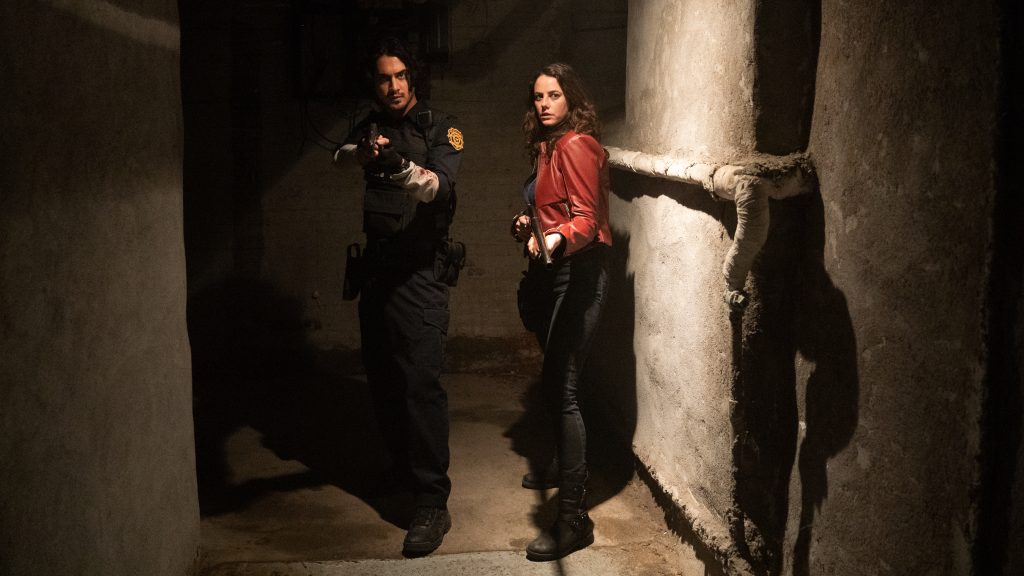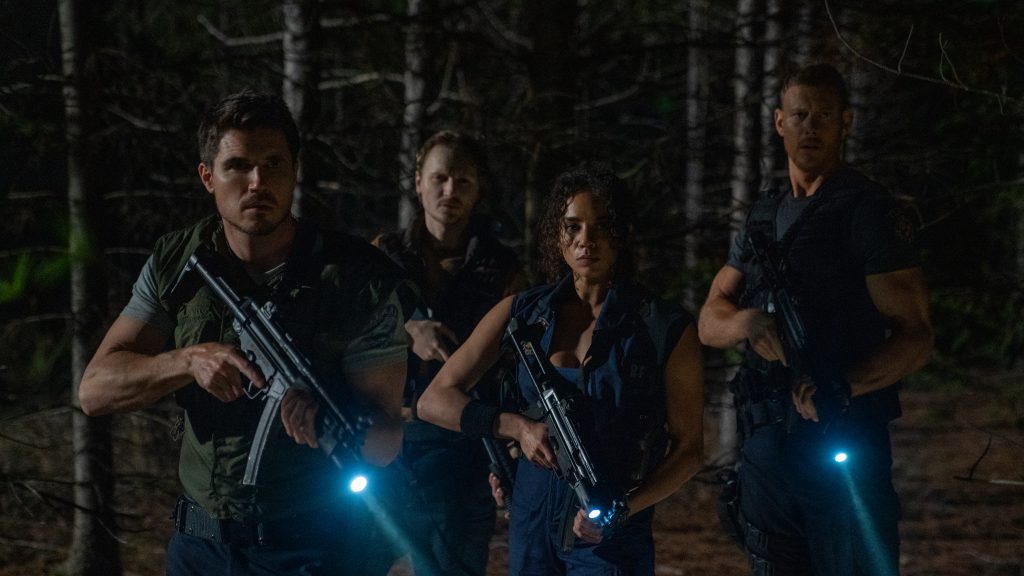November 22, 2021
by Carla Hay

“Resident Evil: Welcome to Raccoon City”
Directed by Johannes Roberts
Culture Representation: Taking place in 1998 in the fictional Midwestern town of Raccoon City, the horror flick “Resident Evil: Welcome to Raccoon City” features a predominantly white cast of characters (with a few multiracial people) representing the working-class and middle-class.
Culture Clash: A woman in her 20s returns to her childhood hometown of Raccoon City to visit her cop brother, only to discover that Raccoon City will soon be overtaken by zombies and is the target of a more sinister plan.
Culture Audience: “Resident Evil: Welcome to Raccoon City” will appeal primarily to fans of the “Resident Evil” franchise and anyone who doesn’t mind watching a predictable and silly horror flick.

When will the makers of bad zombie films learn that gory doesn’t always equal scary? “Resident Evil: Welcome to Raccoon City” has plenty of gore but absolutely nothing terrifying or imaginative. It’s just a ridiculous rehash of all the things of people hate the most about terrible horror movies: Shallow characters who make dumb decisions; unrealistic action scenes; and muddled storytelling that fails to be engaging.
By now, the “Resident Evil” movie series (which is based on the “Resident Evil” video games) has such a tarnished reputation for being low-quality junk that audiences should expect that any movie with the words “resident evil” in the title will be nothing but schlock. But schlock can be entertaining if it’s done the right way. Unfortunately, “Resident Evil: Raccoon City” is more of the same disappointing garbage.
Paul W.S. Anderson, the writer/director of most of the “Resident Evil” movies, is not the writer/director of “Resident Evil: Welcome to Raccoon City,” but he is an executive producer. Instead, Johannes Roberts wrote and directed “Resident Evil: Welcome to Raccoon City,” a prequel that starts off with the most tiresome cliché of tiresome clichés in a horror movie: The “fake-out freak-out” scene where something frightening is supposed to be happening. But surprise! It was only someone’s nightmare. This is how the movie’s two sibling main characters are introduced.
Claire Redfield (played by Kaya Scodelario) and her older brother Chris Redfield (played by Robbie Amell) are first seen as children in the Raccoon City Orphanage, where they have been living since their parents died in a car accident. Claire is about 8 years old, while Chris is about 10. Raccoon City is in an unnamed U.S. state in the Midwest. (“Resident Evil: Raccoon City” was actually filmed in Canada, in the Ontario cities of Sudbury and Hamilton.)
While at the orphanage, which looks more like hospital in a war zone, it’s nighttime, and Claire is woken up by someone who seems to have touched her. Viewers will see a gnarly and dirty hand with long fingernails outstretched as if it’s going to hurt Claire, but the hand suddenly pulls back.
Claire tells Chris what she thinks she saw. “She’s here again!” Claire says in an alarmed voice. Chris tells Claire that whatever Claire saw, it was probably her imagination. However, Claire is convinced that something strange is in the orphanage. She takes a look around the orphanage to investigate.
And sure enough, crouched in the corner of a room in a makeshift tent is a mutant-looking woman, with matted hair and distorted physical features. It’s the same woman who tried to wake up Claire. This severely disfigured woman, who doesn’t look entirely human, is wearing a wristband with the name Lisa Trevor (played by Marina Mazepa). Claire now knows this woman’s name.
Instead of screaming or running away, like most people would do, Claire calmly asks, “Where do you live?” The woman writes down on a piece of paper: “Below.” Suddenly, the orphanage’s resident doctor appears and startles Claire by asking her: “What are you doing, little girl?” It’s then that Claire screams out loud, and the scene cuts to the adult Claire waking up because this entire childhood scene was supposed to be a nightmare.
It’s now 1998, and Claire is now in her late 20s. Her nightmare happened while she was napping in the passenger seat of a truck. She’s a hitchhiker on her way to visit Chris. And the sleazy truck driver (played by Pat Thornton) who’s giving her this ride is trying to put some moves on her, but she’s clearly not interested. Don’t expect this movie to reveal what Claire is doing with her life, but she obviously doesn’t have the money to rent a car, take a taxi or hire a car service.
It’s pouring rain at night, as it often does in horror movies when people are driving on a deserted road and this next thing happens: Someone suddenly appears out of nowhere in front of the automobile, like a ghostly figure. In this movie, the wannabe road-kill stranger is a woman, and the truck driver ends up hitting her because he couldn’t swerve away fast enough.
When the trucker and Claire get out of the truck, the bloodied woman hisses like the zombie that she is, and she runs away into a nearby wooded area. Meanwhile, the trucker has a dog that gets out of the truck too. The dog licks some of the zombie’s blood off of the street, so you know what’s going to happen to the dog later in the movie.
Somehow, Claire makes it to Chris’ home. Instead of seeing if he’s home, she just breaks into the house like a thief. It turns out that she hasn’t seen or spoken to Chris for five years, and her visit is unannounced, but it’s still no reason to break into his house. It’s just an example of how stupid this movie is. Chris is home and is shocked to see Claire, who tells him sarcastically that he’s not a very good cop if he doesn’t have good security for his home.
Claire notices a framed photo in Chris’ house that seems to disturb her. He’s in the photo with the same scientist/doctor who frightened Claire in her nightmare. This scientist really exists and he’s a menacing person from Claire’s past. His name is William Birkin (played by Neal McDonough), who is the movie’s obvious villain. (He’s got plenty of sneers, smirks and crazy-eyed stares to make it obvious.)
Claire’s immediate reaction is repulsion when she finds out that William has become a father figure/mentor to Chris. A flashback in the movie later shows why she thinks William is evil. Chris, on the other hand, completely trusts William. Chris tells Claire that William helped Chris out a lot in life, and William is the closest thing that Chris has to family. Of course, since the movie telegraphs so early that William is an evil scientist, there’s no suspense at all when his “secret” is revealed.
It’s explained in some captions on screen that Raccoon City used to be a thriving community. The city’s biggest employer was a pharmaceutical company called Umbrella Corporation, which had its headquarters in Raccoon City. However, a scandal nearly destroyed the company. And now, Raccoon City is a shadow of its former self. The only people who have remained in Raccoon City are some employees of Umbrella and “people who are too poor to leave.”
It’s revealed a little later in the movie that Claire ran away from Raccoon City when she was a teenager. Chris somewhat resents her for it because he feels that she abandoned him, and she’s the only biological family that he has. Why is Claire back in Raccoon City if she dislikes it so much? She’s had a “premonition” that something bad is going to happen there, and she wants to convince Chris to move out as soon as possible.
She shows Chris a videotape that she has of a former Umbrella employee named Ben Bertolucci (played by Josh Cruddas), who claims to be a whistleblower exposing some of the company’s secrets. One of the biggest secrets is that Umbrella “poisoned the water” in the area. And there was a “really bad leak” that could do Chernobyl-like damage to the area. Ben says he has information that this explosion will completely destroy Raccoon City by 6 a.m. on the day after Claire has arrived to urge Chris to evacuate.
Most of the action in the movie starts after 11 p.m. on the night before this supposed explosion, and then the climactic part of the movie is close to the 6 a.m. deadline. And where exactly is Ben now? That’s shown in the movie, but in a very haphazard way.
At first, Chris doesn’t think there’s any merit to Ben’s claims. But then, people in Raccoon City start turning into zombies. It becomes a race against time to not only survive the zombies but also try to find a way out of Raccoon City before it supposedly explodes.
This relatively low-budget movie has a relatively small cast of characters. The only people who are seen actively trying to leave Raccoon City are Claire, Chris and Chris’ co-workers in Raccoon City’s small police force. These other cops are:
- Chief Brian Irons (played by Donal Logue), who’s a loud-mouthed bully.
- Leon S. Kennedy (played by Avan Jogia), a mild-mannered rookie cop who is the target of Chief Irons’ worst taunting.
- Jill Valentine (played by Hannah John-Kamen), a sassy extrovert who seems to be attracted to Leon, even though she’s dating another co-worker.
- Albert Wesker (played by Tom Hopper), who is Jill’s boyfriend and someone who thinks he’s the bravest one on the police force.
- Richard Aiken (played by Chad Rook), a generic and forgettable cop.
Leaving the city isn’t as easy as it sounds. Government officials have sealed off the roads leading out of the city and have stationed armed security at the borders to prevent anyone from leaving. One of the characters in the movie finds out the hard way about these barriers. The cops try to exit Raccoon City by getting a helicopter from a guy named Brad Vickers (played by Nathan Dales), but that plan doesn’t go smoothly.
And because this movie takes place in 1998, smartphones don’t exist. Needless to say, the landline phones aren’t working during this crisis. There’s brief mention of Internet service, but this is in the days of dial-up Internet service, which needed landlines. In 1998, an example of cutting-edge mobile technology was a PalmPilot, which someone is seen using in the film, even though it doesn’t help that person get out of this emergency situation.
One of the many reasons why this movie looks so phony is that all the young cops in the movie look exactly like who they are: physically attractive Hollywood actors. There are no “average” lookers in this bunch of young, subordinate cops. The only middle-paged person on the police force is Chief Irons, who turns out to be a coward of the worst kind. You don’t have to be a cop to know that there’s no city police force in the world where everyone except the leader is a good-looking person under the age of 40.
Maybe the filmmakers of “Resident Evil: Welcome to Raccoon City” think that having “eye candy” cops would distract viewers from the movie’s dumb plot. One of the more ludicrous scenes in the movie takes place at an eatery called Emmy’s Diner. Leon notices that his waitress Jenny (played by Louise Young) has a right eye that’s bleeding.
When he shows concern and asks Jenny if she’s had a doctor examine her eye, she says no. Jenny adds that her eye has been bleeding this way for the past two weeks, but “it’s no big deal.” Of course, we all know what’s going to happen to that waitress in this zombie movie.
Everything is so monotonously formulaic in “Resident Evil: Welcome to the Raccoon City.” After a while, you can almost do a countdown to the clichés that will come next. There are too many scenes where someone shows up at just the right moment to “come from behind” to shoot someone. One particular character in this movie is saddled with this over-used cliché.
And for a movie about zombies, the cops are woefully incompetent in killing them. They often don’t shoot the zombies in the head. And if they do, they don’t check to see if the zombie is really dead. It’s all just a way to pad and stretch out the story with weak attempts at jump scares involving zombies that looked like they’ve been killed but aren’t really dead after all.
None of the acting in this movie is very impressive. Jogia portrays Leon as having a mostly nonchalant attitude during this whole crisis, with only a few scenes where he looks realistically frightened. McDonough goes in a completely opposite direction because his wild-eyed performance is very over-the-top. The filmmakers intend to make Leon an underdog whom audiences are supposed to root for to succeed. However, the movie tells almost nothing about Leon except that his father is a high-ranking police officer in another city, and Leon was transferred to Raccoon City as punishment for accidentally shooting his cop partner in the rear end.
The movie’s visual effects are adequate, but there’s nothing innovative at all. Lisa is supposed to look like a “two-headed monster” with a mask made out of flesh. It literally looks like the movie’s makeup department just glued a mask to the actress’ face to make it look like she has two heads sticking out of her neck. Everything in “Resident Evil: Welcome to Raccoon City” has been done already in better horror flicks about zombies or mutants.
Claire is the story’s central protagonist, but viewers will learn nothing about who she was as an adult before she arrived in Raccoon City. For a better thriller movie starring Scodelario, see 2019’s “Crawl,” where she plays a college student trapped in a house with alligators during a hurricane. “Resident Evil: Welcome to Raccoon City” has a mid-credits scene with the appearance of mysterious spy character Ada Wong (played by Lily Gao), but this cameo does nothing to redeem the rest of this junkpile movie.
Screen Gems will release “Resident Evil: Welcome to Racoon City” in U.S. cinemas on November 24, 2021.
